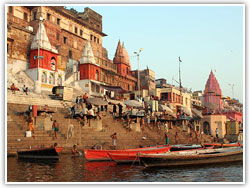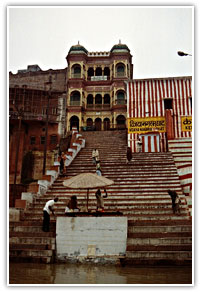|
|
Varanasi Ghats
.............................................................................................................................................................................. |
|
Ghats, Varanasi
The Ghats and the human activity on them are the
principal attraction for the tourists to Varanasi.
The Ghats are the wide stone steps that leads down
to the river for almost 5 km along the west bank
of the River Ganges in Varanasi. Thousands of
pilgrims and devotees visit these Ghats to
meditate and purify themselves by taking a bath in
the holy river Ganges. Behind the Ghats rise the
magnificent superstructure of temples, havelis,
domes and minarets of mosques.
|
 |
|
|
Viewing
the ghats early in the morning from a boat on the river
can be an unforgettable experience. In the early morning
the mist clears, the light is brighter and the ghats
reverberate with the chant of mantras, the sound of
bells and the cries of the vendors.
Varanasi has about 100 ghats. Many
are bathing ghats but at the others, cremations are
conducted. Many of these ghats were built when the
Marathas controlled the city and the Scindias, the
Peshwas, Holkars and Bhonsles stand out as patrons of
Varanasi. Even today many of the ghats are privately
owned. The Shivala or Kali Ghat is still owned by the
former Maharaja of Varanasi. The main bathing ghats are
Assi, Dasaswamedh, Barnasangam, Panchaganga and
Manikarnika. To bath at these five ghats in this order
in a day is known as the Panch Tirtha Yatra.
Various legends are associated with the ghats.
Dashashvamedha Ghat takes its name from a complicated
ritual ‘The Place of Ten Horse Sacrifices’ that was
performed by the King of Kashi, Divodasa, in the age of
the gods. Divodasa had been appointed king by Brahma,
God of creation, at a time when the world was in chaos
and he accepted the job only if all the god would leave
Varanasi and let him do his job unhindered. Even Siva
was forced to leave but he set the test for Divodasa
confident that he would get the ceremony wrong and this
would allow the God back into the city. Siva was wrong
as the ritual was performed flawlessly. The ghat has
thus become one of the holiest and bathing here is
regarded as meritorious as making the sacrifice.
The Shivala Ghat is situated after the temple. The
uninspiring temple houses an image that is sprinkled
with ganga water. The ghat is especially popular with
women. The Munshi Ghat is a place where some of the
city’s sizeable Muslim population come to bathe. The
river has no religious significance for them. Adjacent
are the Pandeya Ghat and Rana Ghat, the latter built by
the Maharana of Udaipur. Professional washermen work at
the Dhobi Ghat. Their method is to soak the clothes in
the river mud, beat them around a bit, then rinse. There
is religious merit in having your clothes washed in the
sacred Ganga. The Raja Ghat is associated with the Raja
of Pune and here the high-water levels are recorded. You
can see from the flood level marked in July 1967 that at
times the steps can be almost completely covered,
difficult to imagine when the river is at its lowest ebb
in Jan or Feb. Next is the Kedara Ghat, named after
Kedarnath, a pilgrimage site in the Uttaranchal. This
ghat is especially popular with Bengalis and South
Indians. The Tulsi Ghat is dedicated to great saint
Tulsi Das who wrote the 'Ram Charit Manas', the Hindi
translation of the Ramayana.
The Harishchandra Ghat is
particularly holy and is dedicated to the king
Harishchandra whose devotion to Brahma was given a
series of rigourous of tests by the god. Harishchandra
performed these, including becoming a servant at the
Varanasi crematorium, so the impressed Brahma named this
ghat after him. It is now the most sacred cremation ghat.
Behind the ghat is a gopuram of a Dravidian style
temple. The Karnataka Ghat is one of many regional ghats.
These are attended by priests who know the local
languages, castes, customs and festivals. |
|
|
|
The Hanuman Ghat is where Vallabha, the leader of
a revival in the Krishna Bhakti Cult is believed
to have been born at the end of the 15th century.
This is popular with bodybuilders and wrestlers
since Hanuman epitomizes the qualities associated
with these sports. The Hanuman Ghat has the
Hanuman temples and Kanchi Kam Kotishwara. Chet
Singh’s Fort stands behind the Sivala Ghat. The
fort was the old palace of the Maharajas, was
taken by the Muslims and retaken by Chet Singh. He
later made an escape from the British who had
imprisoned him in his own fort for tax evasion by
climbing down to the river and swimming away. Jain
Ghat is used by Jain devotees. The Bachraj Ghat is
used by Jain devotees for it has three river bank
Jain temples. Anandamayi Ghat is named after the
Bengali Anandamayi who died in 1982. She was born
in a poor family, received enlightnment at the age
of 17 and spent her entire life teaching and
|
 |
|
|
setting
up charitable missions. One of her ashrams is here. Her
name Anandamayi Ma means ‘Mother of Bliss’. Furthest
upstream is the Asi Ghat, one of five that pilgrims
should bathe from in a day. The order is: Asi,
Dasasvamedh, Barnasangam, Panchganga and Mainkarnika.
Man mandir Ghat was built by
Maharajah Man Singh of Amber in 1600 and is one of the
oldest in Varanasi. The palace here has been much
restored in the last century with brick and plaster. The
fine stone balcony on the north-east corner gives an
indication of how the original looked. Maharaja Jai
Singh of Jaipur converted the palace into an observatory
in 1710. The instruments are inside but not used. Near
the entrance is a small Siva Dalbhyeshvara Temple whose
shrine is a lingam immersed in water. During drought,
water is added to the cistern to make it overflow for
good luck. Dom Raja’s house is next door. The Doms are
the Untouchables of Varanasi who are integral to the
cremation ceremony. As Untouchables they can handle the
corpse, a ritually polluting act for Hindus. They also
supply the flame from the temple for the funeral pyre.
Their presence is essential and also lucrative since
there are fees for the various services they provide.
The Dom Raja is the hereditary title of the leader of
these Untouchables. Mir Ghat leads to the Nepalese
temple of Vishalakshi. The Lalita Ghat has a beautiful
temple built in carved wood by the late King of Nepal.
Above the Marnikarnika Ghat is a well into which Siva’s
dead wife Sati’s earring is supposed to have fallen when
Siva was carrying her after she committed suicide. The
Brahmins managed to find the jewel (marnikanika) from
the earring and returned it to Siva. He blessed the
place. Offerings of bilva flowers, milk, sandalwood and
sweetmeats are thrown into the tank. Between this and
the ghat is Charandapuka, a stone slab with the
footprints of Vishnu. A few privileged families are
allowed cremations here. The Marnikarnika Ghat is
immensely popular as a burning ghat. Dattatreya Ghat is
named after a Brahmin who left his footprint here.
Scindia’s Ghat was originally built in 1830 but it was
so huge that it collapsed and had to be done again. Ram
Ghat was built by the Maharaja of Jaipur. The Mansarover
Ghat was also built by Man Singh of Amber.
Five rivers are supposed to meet at the magnificent
Panchganga Ghat – the Ganga, Sarasvati, Yamuna, Kirana
and Dhutupapa. It is one of the five main pilgrimage
ghats in Varanasi. The impressive flights of stone steps
run up to the Smaller Mosque of Aurangzeb (late 17th
century) which occupies the site of an earlier Vishnu
Temple. Early European visitors to India such as
Tavernier, marveled at the size and opulence of the
temple and its images. It is, perhaps, not surprising
that Aurangzeb knocked it down. At Gaya Ghat there is a
stone statue of a sacred cow while at Trilochana Ghat
there is a temple of Siva in his form as the
‘Three-eyed’ (Trilochana). There are two turrets
sticking out of the water. Raj Ghat is the last on the
boat journey. Excavations have revealed that there was a
9th century BC city situated on a grassy knoll near
here. Raj Ghat was where the river was forded until
bridges were built across the river. |
|